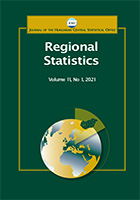Exploring the profile of innovative enterprises in high-tech manufacturing sectors: The case of the regions of Madrid and Catalonia in 2016
Exploring the profile of innovative enterprises in high-tech manufacturing sectors: The case of the regions of Madrid and Catalonia in 2016
Author(s): Betsabé Pérez Garrido, Viktoriia Semenova, Szabolcs Szilárd SebrekSubject(s): Social Sciences, Economy, Geography, Regional studies
Published by: Központi Statisztikai Hivatal
Keywords: innovation performance; product innovations; regional implications; discrete choice models; fixed and random parameters
Summary/Abstract: This study explores the innovation profiles of Spanish enterprises operating in high-tech manufacturing sectors. Firms with corporate headquarters in one of two prominent regions are considered: Madrid or Catalonia. The innovation profiles describe a firm’s capacity to engage in radical, continuous, or no product innovation and represent distinct degrees of innovation performance. They are elaborated by applying two types of discrete choice models: (a) a multinomial logit model, which permits only the estimation of fixed effect parameters, and (b) a flexible mixed-logit model that permits the simultaneous specification of fixed and random parameters. The mixed logit methodology indicates that internal research and development (R&D) funds play no role in innovation in Catalonia. Meanwhile, Madrid-headquartered enterprises are associated with a preference only for incremental rather than radical innovation. The impact of external R&D is significantly more important for Madrid-based firms than for Catalonian ones, but the situation with expenses dedicated to technological development is the reverse. The size of researchers’ salaries plays a relevant role in innovation in both regions: in Madrid, radical innovation over incremental innovation and non-innovation are unanimous preferences. However, there are roughly equal chances for both product innovation outcomes in Catalonia. Firm size proves to be a meaningful random variable in relation to innovation performance in both Spanish regions. Concerning its association with the radical/‘no innovation’ outcome, the results are the same in the focal regions, which display an equal preference for the two choices. Larger size induces Madrid firms to prefer radical innovation to incremental innovation, while Catalonian enterprises consider the latter equally important. Although there is no significant effect in Catalonia, firm size in the Madrid sample is associated with equal preferences for incremental innovation and no product innovation. This study describes firm attributes that enhance product innovation performance in high-tech manufacturing sectors in two distinct regions with above-average within-country per capita gross domestic product (GDP). Methodologically, this shows the importance of using enriched alternative computational approaches, where a mixed logit specification along the multinomial one allows for the simultaneous estimation of fixed- and random-effect parameters in the model, generating additional insight into enterprise attributes regarding the innovation performance phenomena under analysis.
Journal: Regional Statistics
- Issue Year: 13/2023
- Issue No: 01
- Page Range: 119-148
- Page Count: 30
- Language: English

